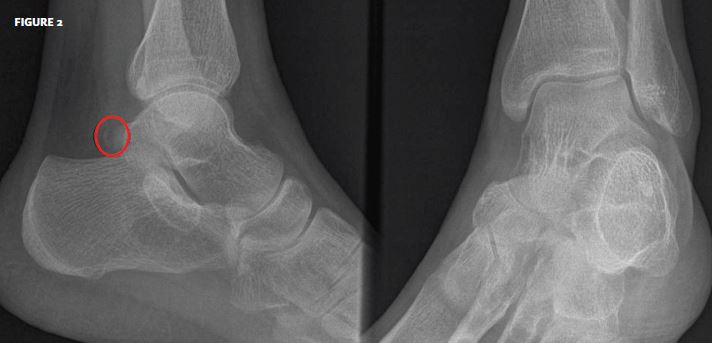
The x-ray shows minimally displaced fractures of the posterior process of the talus. The patient was placed in a short cast at the urgent care site, with advice to avoid putting weight on the affected limb and to follow up with an orthopedist within three days.
Typically, such injuries are treated with a short leg cast for four to six weeks, with some suggesting 15 degrees of plantar flexion.1
Two processes the lateral and the posterior project from the body of the talus. Either process may be fractured, either as an isolated injury or in conjunction with other ankle/talar injuries.
Differential diagnoses of posterior ankle pain include the following:
- Fracture of the lateral tubercle of the posterior process (also known as Sheppard’s fracture). This is characterized by inversion of the ankle, which may avulse the tubercle, leaving the posteri- or talofibular ligament It may also occur when the ankle is forced into extreme equinus. Patients may present with ankle-sprain-like symptoms; posterolateral ankle tenderness may be elicited, with decreased and painful motion of the ankle and subtalar joints. In addition, active flexion of the great toe may produce pain as the flexor hallucis longus (FHL) moves over the fracture site between the medial and lateral tubercles.
The lateral tubercle has an articular surface; fracture through this tubercle is often associated with arthrosis.
- Fracture of the medial Look for tenderness and, perhaps, a mass just posterior to the medial malleolus, as well as pain with motion of the great toe the latter due to motion of the FHL. Treatment may involve excision of the fragment.1
Reference
- Fractures of Posterior Process of Talus. Wheeless’ Textbook of Orthopaedics. Available at: www.wheelessonline.com/ortho/fractures_of_posterior_process_of_talus. Acknowledgment: Case presented by Nahum Kovalski, BSc, MDCM; the patient was treated by Dr. Eliyahu Sheleg.

